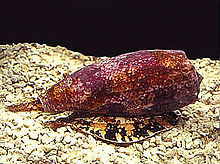- Conus geographus
-
Gastridium geographus 
A live specimen of Gastridium geographus Scientific classification Kingdom: Animalia Phylum: Mollusca Class: Gastropoda (unranked): clade Caenogastropoda
clade Hypsogastropoda
clade NeogastropodaSuperfamily: Conoidea Family: Conidae Subfamily: Coninae Genus: Gastridium Species: G. geographus Binomial name Gastridium geographus
Linnaeus, 1758 [1]Synonyms[2] Gastridium geographus (Linnaeus, 1758)
Gastridium geographus, common name the geography cone, is a species of predatory sea snail, a marine gastropod mollusk in the family Conidae, the cone snails, cone shells or cones. Although all cone snails hunt and kill prey using venom, the venom of this species is known to be especially potent. [2] Live cone snails of this species should not be handled or only handled with extreme caution, because they will sting humans, sometimes with serious results.
Contents
Shell description
Gastridium geographus has a broad, thin shell, cylindrically inflated. Geography cones grow to about 4 inches (10 cm) to 6 inches (15 cm) in length. The size of an adult shell varies between 43 mm and 166 mm. The ground color of the shell is pink or violaceous white, occasionally reddish. It has a mottled appearance, clouded and coarsely reticulated with chestnut or chocolate, usually forming two very irregular bands. This intricately brown-and-white pattern is highly prized by shell collectors.[3]
The geography cone has a wide, violaceous white or pink aperture and numerous shoulder ridges or spines.[2] The shell is covered with thread-like revolving striae, usually nearly obsolete except at the base. The flattened spire is striated and coronated. [2] [4]
In comparison with other species, the shell has a noticeably wider and convex mid-body, with a flattened spire. Its walls are also noticeably thinner and lighter compared to other cone shells of similar length and size.
Distribution
Geography cones are common. They occur in the Red Sea, in the Indian Ocean along Chagos, Madagascar, Mauritius, Mozambique and Tanzania. They are indigenous to the reefs of the Indo-Pacific region, except for Hawaii.[3]
Venom
Main article: ConotoxinGastridium geographus is highly dangerous - live specimens should be handled with extreme caution.[2] Conus geographus has the most toxic sting known among Conus species and is responsible for more than thirty human fatalities.[3][5] Their venom, a complex of hundreds of different toxins, is delivered through a harpoon-like tooth propelled from an extendable proboscis. There is no antivenom for a cone snail sting, and treatment is limited to merely keeping victims alive until the toxins wear off.[3]
Among the compounds found in cone snail venom are proteins which, when isolated, have enormous potential as pain-killing drugs. Research shows that certain of these proteins target specific human pain receptors and can be up to 10,000 times more potent than morphine without morphine's addictive properties and side-effects.[3]
Conantokin-G is a toxin derived from the venom of Conus geographus.
Ecology
Gastridium geographus is a piscivore that dwells in sediment of shallow reefs,[2] preying on small fish.
References
This article incorporates CC-BY-3.0 text from the reference.[2]
- ^ Linnaeus, C., 1758. Systema Naturae per Regna Tria Naturae, 10th ed., 1
- ^ a b c d e f g WoRMS (2010). Gastridium geographus Linnaeus, 1758. Accessed through: World Register of Marine Species at http://www.marinespecies.org/aphia.php?p=taxdetails&id=215499 on 2011-07-24
- ^ a b c d e "Geographic Cone Snail Profile". National Geographic Society. http://animals.nationalgeographic.com/animals/invertebrates/geographers-cone-snail.html. Retrieved 31 December 2009.
- ^ George Washington Tryon, Manual of Conchology, vol. VI p. 88; 1879
- ^ Conus geographus Linnaeus, 1758 - Record: CONUS BIODIVERSITY WEBSITE CATALOGUE
- Filmer R.M. (2001). A Catalogue of Nomenclature and Taxonomy in the Living Conidae 1758 - 1998. Backhuys Publishers, Leiden. 388pp
- Tucker J.K. (2009). Recent cone species database. September 4th 2009 Edition
- Tucker J.K. & Tenorio M.J. (2009) Systematic classification of Recent and fossil conoidean gastropods. Hackenheim: Conchbooks. 296 pp
External links
Categories:- Conus
- Animals described in 1758
Wikimedia Foundation. 2010.



